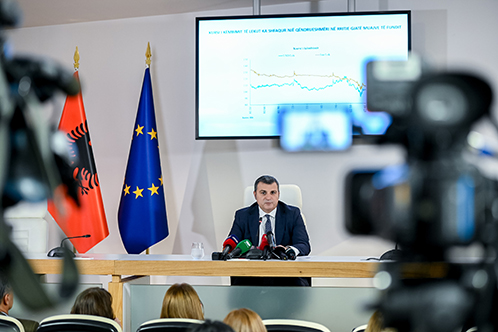BANK OF ALBANIA
PRESS RELEASE
Governor Sejko: Statement to the Press Conference on Monetary Policy Decision, 1 November 2023
Publication date: 01.11.2023
Today, on 1 November 2023, the Supervisory Council of the Bank of Albania reviewed and approved the Quarterly Monetary Policy Report.
The new information analysed in this Report has resulted, overall, in line with our expectations. Despite a challenging external environment, the economic activity in Albania, has grown over 2023, while inflation has dropped progressively. These positive trends are expected to continue in the future as well.

However, the Supervisory Council deemed that the domestic inflationary pressures still are persistently high. For this reason, in today's meeting, the Supervisory Council decided to reduce the intensity of monetary stimulus, in order to establish the adequate financial conditions for inflation to return to target, within the next year.
[Below, I will outline today's decision and explain in more detail the rationale behind archiving it.]
***
In 2023 Q3, the consumer price inflation recorded an average level of 4.1%, thus continuing the falling trend of the two previous quarters. The reduction in inflation in this quarter reflected – to a large extent - the decline in food inflation. On the other hand, inflation in other items of the basket was relatively stable, whilst oil prices picked up as geopolitical tensions intensified.

From the macroeconomic perspective, the fall in inflation over 2023, was mostly dictated by the drop in imported inflation. This trend reflects the overall stabilisation of commodity prices in international markets, the decline of inflation in our trading partners, as well as the appreciation of the lek exchange rate in the last two years. In parallel, domestic inflationary pressures have also been decreasing, although they still remain relatively high and stable. Against this backdrop, the pace of inflation’s decline decelerated in the third quarter, while core inflation continues to remain above the target.
The Albanian economy continues to settle on a positive development trend. The volume of economic activity grew by 3.2% in the second quarter, marking an improvement compared to the previous period. Available indirect data suggest that this growth trajectory has continued in the third quarter as well. The expansion in both consumption and private investments, coupled with the increase in income from tourism underpinned the economic growth. The latter is reflected in the expanded activity in the sectors of services and construction, while the performance across the other sectors of economy was weaker.
The stable rise in the demand for goods and services has pushed the economy to the positive stage of the business cycle. This stage is reflected in: the improved financial situation of businesses and consumers; the continuous increase in employment; and the fast rise in wages and production costs. In this context, wages in the private sector increased by 15% in the second quarter, the unemployment rate stands close to historical lows, while businesses report difficulties in providing labour force. This dynamic suggests that – although declining – domestic inflationary pressures are not yet in line with our price stability objective.
In macroeconomic terms, growth was fuelled also by the upswing in external demand across certain segments of Albanian exports, the sound balance sheets of private sector, the improved confidence in both enterprises and consumers, and the still simulating monetary and financial environment.
The cautious normalization of the monetary policy stance has helped to control inflation during 2022, and its return to a downward trajectory in 2023, as well as it has enabled the normal functioning of financial markets. This has been accompanied by an overall increase in interest rates in the interbank market, in the government securities market, as well as on deposits and loans in lek. However, the increase in interest rates in Albania is among the lowest in the region, and financing costs and conditions still remain stimulating. In particular, loan interest rates appear stabilized during the third quarter, or on downward trends in certain segments.
In response to them, credit to the private sector has continued to record positive growth rates during this quarter, although at a slower momentum. This slowdown reflects - to a large extent - the improvement in the financial situation of businesses and the reduction in their needs for working capital. Meanwhile, the growth pace of loans for investments and loans for households appears relatively stable. At the same time, the structure of loan portfolio is showing an increasingly greater orientation towards the lek, as a result of the reduction in the spread of interest rates and the appreciation of the exchange rate, while the quality of this portfolio remains high, as displayed from the low NPLs ratio. These developments suggest that the banking system remains ready and able to meet the financing needs of the private sector for expanding investments, increasing consumption and purchasing residential properties.
Parallel to these developments, the lek exchange rate has been increasingly stable over the last few months, while the foreign exchange market has been functioning smoothly and within normal business parameters. This performance suggests the stabilization of the supply and demand ratios for foreign currency at around the current exchange rate levels.
The update of our projections suggests that these trends will continue in the coming period.
Economic activity is expected to be upward over the medium-term horizon, thus helping the increase in employment and wages, in addition to supporting the soundness of the financial balance sheets of enterprises and households. The economic growth pace is expected to slightly slowdown in the next year, as a result of the global economic context and tighter financing conditions, though it is expected to return to its historical momentum in the following years.
In parallel, inflation is expected to decline gradually over the course of next year and return to the target by mid-2024. However, our analyses suggest that meeting this forecast requires a monetary policy response, to enable the further reduction of domestic inflationary pressures.
Last, our forecasts suggest that the main indicators of the country's domestic and external balances: the soundness of the banking sector; public debt and the foreign debt of Albania will remain stable or will be improving.
***
Judging on the above, the Supervisory Council decided to:
- Increase the policy rate by 0.25 percentage points to 3.25%;
- Increase the overnight lending rate by 0.25 percentage points to 4.25%; and
- Increase the overnight deposit rate by 0.25 percentage points to 2.25%.
The Supervisory Council considered that the reduction of the monetary stimulus, through the further normalization of the monetary policy stance, is a necessary measure to guarantee the return of inflation to the target within the next year. It factors the need for a more active role of the monetary policy in terms of balancing the demand and supply for goods and services, given the expectations for a more stabilized exchange rate and a more neutral fiscal policy in the medium-term horizon. In this context, it serves to preserve the purchasing power of the Albanian households, guarantee the monetary and financial stability of the economy, as well as the sustainable and long-term growth of Albania.
Also, the Supervisory Council notes that this decision was consistent with our previous communications, and continues to maintain the overall stance of the monetary policy in stimulating positions.
Finally, the Supervisory Council highlights that the high inflationary pressures from the domestic economy remain a risk factor for price stability in Albania, and that the balance of risks to inflation has shifted upwards. In this view, it emphasises the willingness to continue the normalisation process of monetary policy stance, if this measure will be considered necessary to guaranteeing our objective of price stability.

 Linkedin
Linkedin
 Twitter
Twitter
 Youtube
Youtube
 Facebook
Facebook
 Flickr
Flickr
 RSS
RSS
 Subscribe
Subscribe
 Feedback
Feedback